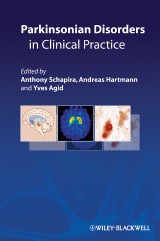Details

Parkinsonian Disorders in Clinical Practice
1. Aufl.
|
68,99 € |
|
| Verlag: | Wiley-Blackwell |
| Format: | |
| Veröffentl.: | 27.04.2009 |
| ISBN/EAN: | 9781444306392 |
| Sprache: | englisch |
| Anzahl Seiten: | 208 |
DRM-geschütztes eBook, Sie benötigen z.B. Adobe Digital Editions und eine Adobe ID zum Lesen.
Beschreibungen
This book gives the reader an up-to-date, clear and logical idea of what caring for parkinsonian patients entails - a challenge that clinicians will face for many years to come. It is split into three sections: <p>Section 1: A compilation of the major brain lesions typically seen in PD</p> <p>Section 2: Treatment options in PD</p> <p>Section 3: 25 cases designed to test the reader and the practical application of the information supplied in the other sections.</p>
Preface. <p>Introduction.</p> <p><b>1 What is Parkinson’s disease? From pathophysiology to</b> <b>symptoms</b> (<i>Andreas Hartmann, Yves Agid, Anthony Schapira).</i></p> <p>I. Pathophysiology of Parkinson’s disease.</p> <p>1. Dysfunctions of the main neuronal pathways in Parkinson’s disease.</p> <p>a. An overview of neuronal systems affected in Parkinson’s disease.</p> <p>b. Dopaminergic neurons.</p> <p>c. Non-dopaminergic neurons.</p> <p>2. Consequences of dopaminergic neuronal lesions on basal ganglia circuits.</p> <p>a. The dopaminergic nigrostriatal system: pre- and postsynaptic compensatory mechanisms.</p> <p>b. Pathologic alterations of nigrostriatal circuits in Parkinson’s disease.</p> <p>3. Histopathology of Parkinson’s disease.</p> <p>4. The etiopathogenesis of Parkinson’s disease.</p> <p>a. The genetics of Parkinson’s disease: any clues for the sporadic forms?</p> <p>b. Relevant environmental factors: focus on mitochondria.</p> <p>c. Mechanisms of cell death in Parkinson’s disease: therapeutic implications.</p> <p>5. Conclusions.</p> <p>a. Parkinson’s disease or Parkinson’s syndromes?</p> <p>b. What Parkinson’s disease is not.</p> <p>II. Clinical features of Parkinson’s disease.</p> <p>1. Motor symptoms.</p> <p>2. Non-motor symptoms.</p> <p>a. Depression.</p> <p>b. Apathy.</p> <p>c. Cognitive impairment.</p> <p>d. Sleep.</p> <p>e. Autonomic dysfunction.</p> <p>f. Sensory symptoms.</p> <p>3. The different forms of Parkinson’s disease: relevance for prognosis.</p> <p>4. The differential diagnosis of Parkinson’s disease.</p> <p>5. Treatment-related symptoms.</p> <p>a. Motor complications.</p> <p>b. Non-motor complications.</p> <p><b>2 Treatment of Parkinson’s disease (</b><i>Anthony Schapira, Andreas Hartmann, Yves Agid).</i></p> <p>I. Antiparkinsonian agents.</p> <p>1. Levodopa.</p> <p>2. COMT inhibitors.</p> <p>3. Dopamine agonists.</p> <p>4. Monoamine oxidase B inhibitors.</p> <p>5. Other drugs.</p> <p>II. Medical management.</p> <p>1. Initiation of treatment.</p> <p>2. Maintenance of treatment (Fig. 2.7).</p> <p>3. Motor complications.</p> <p>4. Management of non-motor complications.</p> <p>III. Non-medical management.</p> <p>1. Surgery.</p> <p>2. Destructive lesions.</p> <p>3. Cell therapy.</p> <p>4. Growth factors.</p> <p>IV. Neuroprotection.</p> <p>1. MAO-B inhibitors.</p> <p>2. Dopamine agonists.</p> <p>3. Coenzyme Q.</p> <p>4. Creatine.</p> <p>5. Antiapoptotic drugs.</p> <p>V. Conclusion.</p> <p><b>3 Case studies.</b></p> <p>Case studies—diagnostic index.</p> <p>Index.</p>
<p><strong>Anthony HV Schapira</strong>, MD DSC, FRCP, FMedSci, Professor and Head of Department University College of Clinical Neurosciences, Institute of Neurology, University College London, Queen Square, London UK. Professor of Neurology, National Hospital for Neurology and Neurosurgery and Roayl Free Hospital, London, UK. <p><strong>Andreas Hartmann</strong>, MD, Clinical Investigation Center, Pitie-Salpetriere Hopital, Paris, France. Federation of Nervous System Disease, Pitie-Salpetriere Hopital, Paris, France. National Institute of Health and Medical Research, Paris, France. Pierre and MAric Curie University,?Paris, France. <p><strong>Yves Agid</strong>, MD, PhD, Clinical Investigation Center, Pitie-Salpetriere Hopital, Paris, France. Federation of Nervous System Disease, Pitie-Salpetriere Hopital, Paris, France. National Institute of Health and Medical Research, Paris, France. Pierre and MAric Curie University,?Paris, France.


















